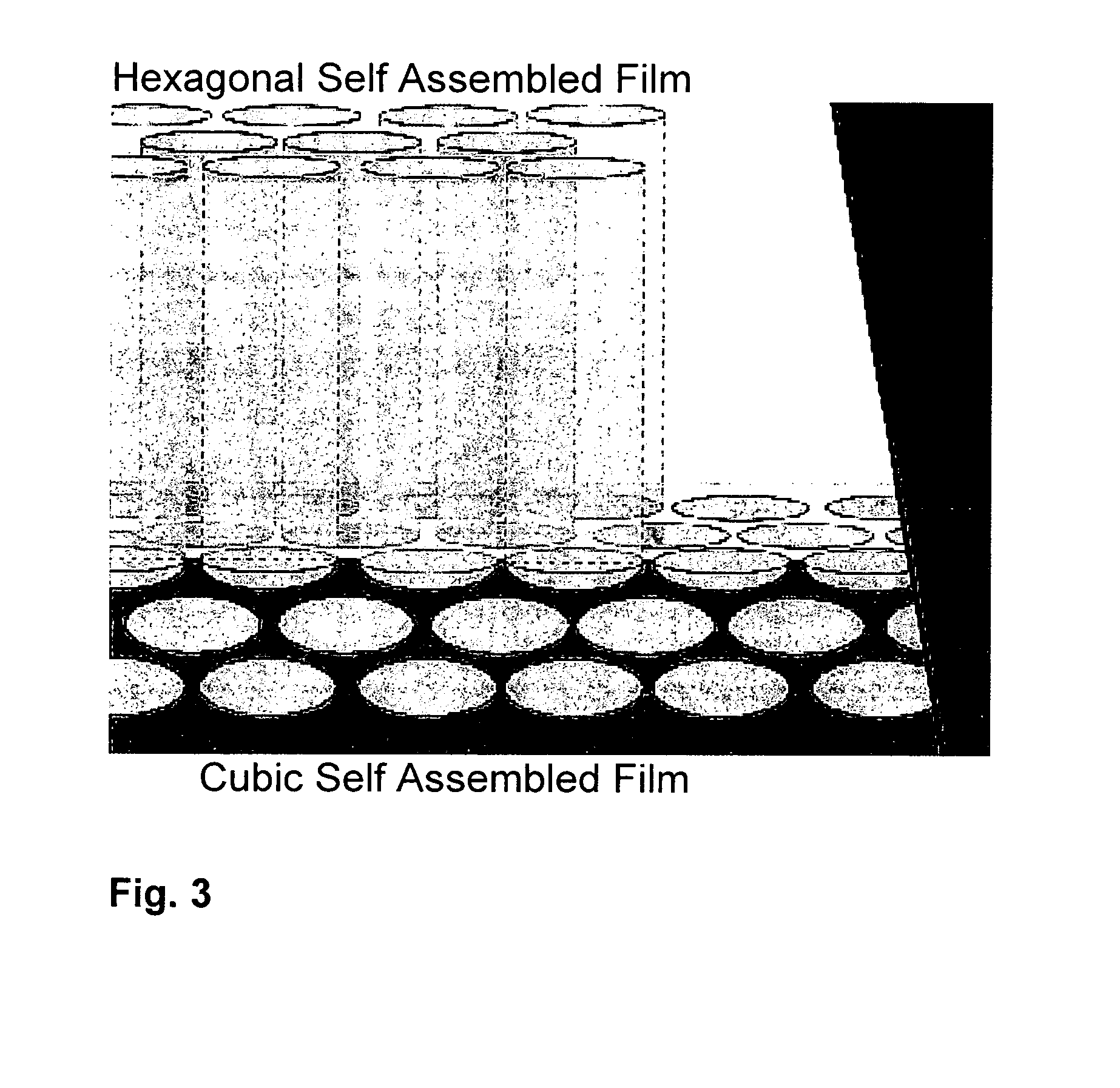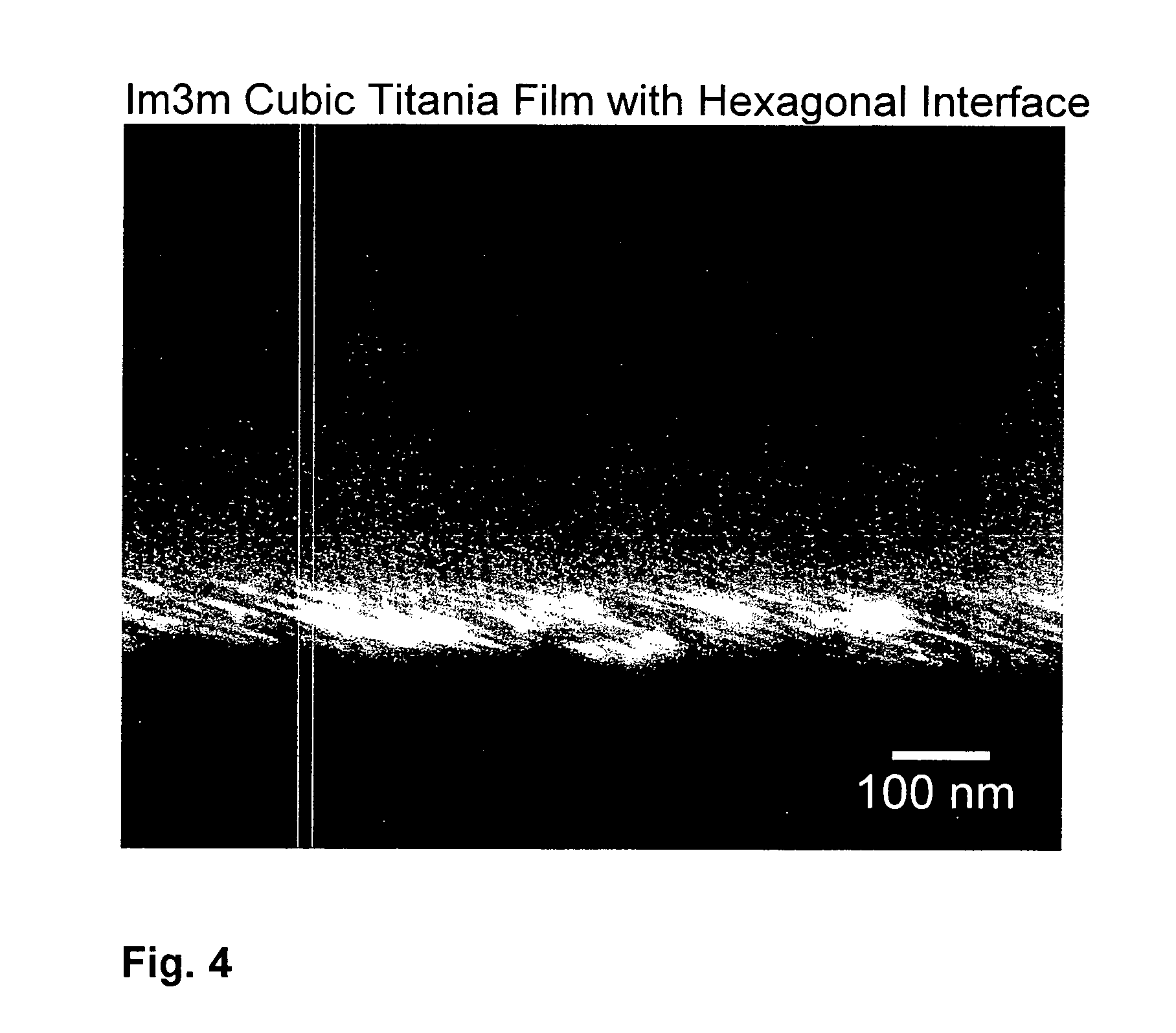Ordered vertically oriented porous inorganic films produced through solution processing
a technology of porous inorganic films and solutions, applied in the field of porous films, can solve the problems of limited throughput of this technique, vertical orientation of volumes, and technique only working for small aspect ratios
- Summary
- Abstract
- Description
- Claims
- Application Information
AI Technical Summary
Benefits of technology
Problems solved by technology
Method used
Image
Examples
example 1
[0031] Referring to FIG. 4, which shows a cross-section SEM image of cubic titania film produced in accordance with this invention, a substrate pattern was generated by cubic mesoporous titania and a slowly crosslinked 2D hexagonal silica film. The solution for the cubic titania was made using a protocol developed by Alberius et al. [17]. In an argon purged container, 4.2 grams of tetraethylorthotitanate was mixed with 3.2 grams of concentrated HCl. After 10 minutes, 1 gram of Pluronic P123 dissolved in 14 grams of ethanol was added. The solution was stirred for 15 minutes and applied via dip casting at 2 cm / minute and the resulting film was aged for 4 days between −10° C. and 10° C. After the aging was complete, the film was crosslinked by heating it first at 60° C. for 24 hours, then at 130° C. for 24 hours. The film was calcined with a 6 hour ramp to 350° C., held for 1 hour and a 6 hour ramp to room temperature. The substrate has a pattern with 15 nm pitch and appropriate hydrop...
example 2
[0034] The procedure in Example 1 produces a film with a capping layer. The top surface of such a film is shown in FIG. 7. To produce a film without the capping layer, the tetramethylammonium chloride is left out of the synthesis. This will generate a film with slightly less straight pores, but open top porosity, as shown in FIG. 6.
example 3
[0035] The procedure of Example 1 can be conducted, following which the top layer can be removed with a plasma etch to produce open pores.
[0036] The foregoing Examples use a two step process that first involves formation of a cubic sub-film, followed by generation of a hexagonal film with vertical pore orientation using the top surface of the cubic film as a patterned nucleation site. The method has been extended to produce vertically oriented hexagonal pores in a single pot synthesis. The method works by producing a film that at the border of the cubic and hexagonal stability fields (which is controlled by the relative concentrations of the organic template and the inorganic precursor). If a composition is chosen that can not stably produce a pure hexagonal or a pure cubic phase, then multiple phases can be produced in a single film. Using a precursor solution that has a reagent composition chosen between the cubic and hexagonal stable regimes allows a film to be produced with bot...
PUM
| Property | Measurement | Unit |
|---|---|---|
| Lattice constant | aaaaa | aaaaa |
| Pore structure | aaaaa | aaaaa |
| Hydrophilicity | aaaaa | aaaaa |
Abstract
Description
Claims
Application Information
 Login to View More
Login to View More - R&D
- Intellectual Property
- Life Sciences
- Materials
- Tech Scout
- Unparalleled Data Quality
- Higher Quality Content
- 60% Fewer Hallucinations
Browse by: Latest US Patents, China's latest patents, Technical Efficacy Thesaurus, Application Domain, Technology Topic, Popular Technical Reports.
© 2025 PatSnap. All rights reserved.Legal|Privacy policy|Modern Slavery Act Transparency Statement|Sitemap|About US| Contact US: help@patsnap.com



